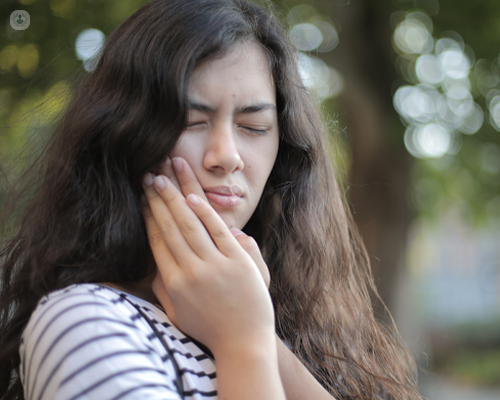Temporomandibular joint disorder (TMJ)
What is the temporomandibular joint (TMJ) and what is TMJ disorder?
The temporomandibular joint (TMJ) allows us to open and close the mouth so we can perform functions like talking, chewing and yawning. This joint connects the bones of the skull and face, with one on each side of the head. It performs three types of movement: moving up and down, going forward and backward, as well as side to side.

Misalignment of the teeth when the jaw closes (which is also referred to as dental malocclusion), orthodontic appliances and stress, as well as bad habits such as clenching the teeth or biting objects can alter the function of the temporomandibular joint. This syndrome can cause pain in the:
- Jaw
- Ears
- Head
- Neck
- Back
- Plus create trouble with chewing.
TMJ disorder treatment is aimed at addressing the causes that have caused the disorder and improving symptoms. It may include:
- Physical therapy
- Exercise
- Medication
- Relaxation techniques
- Mouth guards
- And surgery, although this is rare.
How is TMJ disorder diagnosed?
TMJ disorder can be difficult to diagnose but your doctor or dentist will discuss your symptoms and do a jaw examination. They may listen to the jaw when you open and close your mouth, observe the range of jaw motion or identify sites of pain or discomfort by pressing on areas around your jaw.
They may undertake different imaging tests including:
- A dental X-ray, allowing your dentist to see the bones in and around your jaw as well your teeth placement.
- A CT scan - This gives your doctor the change to see the bones and joint tissue in more detail than an X-ray.
- An MRI (Magnetic resonance imaging), which can reveal any issues with the jaw's structure, the joint's disk or soft tissue surrounding it.
- An arthroscopy - A thin tube with a small camera is inserted into the joint space to view the area in order to make a diagnosis.
What causes TMJ disorder?
It isn't known what causes TMJ disorders in many cases but trauma to the jaw, teeth grinding or genetics can play a part. Other health conditions that may contribute to TMJ disorder developing include:
- Arthritis
- Wearing away, or erosion, of the joint
- Teeth grinding
- Jaw issues that have been present since birth
- Growth disorders
Other factors such as poor posture, joint hypermobility and oestrogen levels in women may play a role in development of TMJ disorder but they have been proven to be a direct cause.
How is TMJ disorder treated?
TMJ disorder isn't life threatening and the symptoms of TMJ may go away without treatment. However, you may have treatment if problems persist. Treatment may be a combination of various types, depending on your dentist or doctor's recommendation. These can be medication, therapies or surgery, as well as home treatment.
Home treatment
In many cases, TMJ disorder symptoms can be eased at home. There are various things you can do:
- Eat soft foods
- Use ice to reduce swelling
- Reduce jaw movements
- Avoid foods that require repetitive chewing, like gum
- Reduce stress
- Improve movement in the jaw by doing jaw-stretching exercises
Medication
Over-the-counter pain medications can solve the pain from TMJ disorders. However, if they aren't enough to relieve it, you may have stronger medication prescribed such as muscle relaxants, antidepressants or prescription-strength ibuprofen.
Therapies
Physical therapy for TMJ disorders may be recommended depending on the case and the area that needs attention. Several therapies can include:
- Heat therapy
- Cooling therapy
- Acupuncture
- Tissue mobilisation
- Resistance exercises
- Jaw stretches
Surgery
If other methods don't help, there are various surgical procedures available for TMJ disorder. These include:
Arthrocentesis
Arthrocentesis is a minimally-invasive procedure that involves the insertion of small needles into the joint. This is so fluid can be irrigated through the joint in order to remove debris and byproducts from inflammation.
Injections
Corticosteroid (a type of steroid) injections or Botox™ can be injected into the jaw muscles used for chewing, and may relieve pain associated with TMJ disorder.
Arthroscopy
As well as diagnosis, arthroscopy can be used for TMJ disorder surgery. A thin tube is inserted into the joint space, then an arthroscope camera is inserted and small surgical instruments are used for surgery. It has fewer risks and complications than open-joint surgery but there are limitations involved, too.
Modified condylotomy
This is mandible surgery, which treats the jawbone, rather than the joint itself. This can be helpful for pain treatment or if you have lock jaw.
Open-joint surgery
Dentists or doctors may suggest repair or replacement of the joint if more conservative treatments haven't worked, and there appears to be a structural problem. There are several risks associated with this procedure in comparison to others, so pros and cons of open-joint surgery for TMJ disorder should be discussed and considered carefully.
Which specialist treats TMJ disorder?
Dentists, who are trained in the anatomy of the jaw, or ENT specialists can treat TMJ disorders. Find some of the best TMJ specialists London has to offer.
This website uses our own and third-party Cookies to compile information with the aim of improving our services, to show you advertising related to your preferences as well analysing your browsing habits. You can change your settings HERE.